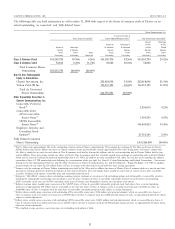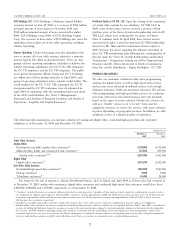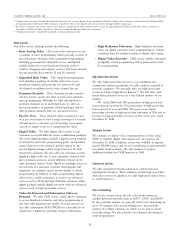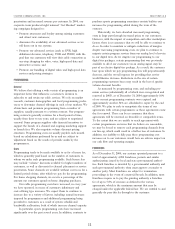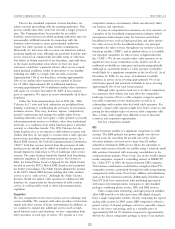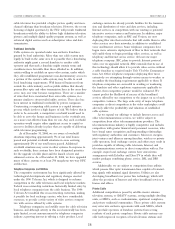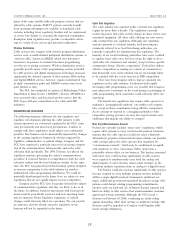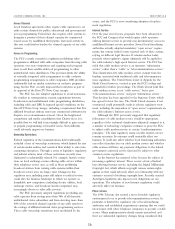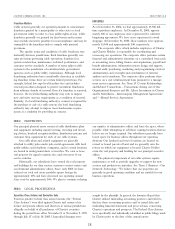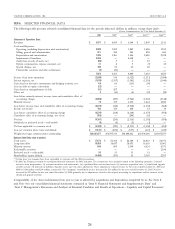Charter 2004 Annual Report Download - page 24
Download and view the complete annual report
Please find page 24 of the 2004 Charter annual report below. You can navigate through the pages in the report by either clicking on the pages listed below, or by using the keyword search tool below to find specific information within the annual report.
CHARTER COMMUNICATIONS, INC. 2004 FORM 10-K
cable television has provided a higher picture quality and more exchange carriers do already provide facilities for the transmis-
channel offerings than broadcast television. However, the recent sion and distribution of voice and data services, including
licensing of digital spectrum by the FCC will provide traditional Internet services, in competition with our existing or potential
broadcasters with the ability to deliver high definition television interactive services ventures and businesses. In addition, major
pictures and multiple digital-quality program streams, as well as telephone companies, such as SBC and Verizon, are now
advanced digital services such as subscription video and data deploying fiber into their networks that will enable them to offer
transmission. video services over their networks, in addition to established
voice and Internet services. Some telephone companies have
Traditional Overbuilds begun more extensive deployment of fiber in their networks that
Cable systems are operated under non-exclusive franchises will enable them to begin providing video services, as well as
granted by local authorities. More than one cable system may telephony and Internet access service. At least one major
legally be built in the same area. It is possible that a franchising telephone company, SBC, plans to provide Internet protocol
authority might grant a second franchise to another cable video over its upgraded network. SBC contends that its use of
operator and that such a franchise might contain terms and this technology should allow it to provide video service without
conditions more favorable than those afforded us. In addition, a cable franchise as required under Title VI of the Communica-
entities willing to establish an open video system, under which tions Act. Other telephone companies deploying fiber more
they offer unaffiliated programmers non-discriminatory access to extensively are attempting through various means to weaken or
a portion of the system’s cable system, may be able to avoid streamline the franchising requirements applicable to them. If
local franchising requirements. Well financed businesses from telephone companies are successful in avoiding or weakening
outside the cable industry, such as public utilities that already the franchise and other regulatory requirements applicable to
possess fiber optic and other transmission lines in the areas they Charter, their competitive posture would be enhanced. We
serve, may over time become competitors. There are a number cannot predict the likelihood of success of the broadband
of cities that have constructed their own cable systems, in a services offered by our competitors or the impact on us of such
manner similar to city-provided utility services. There also has competitive ventures. The large scale entry of major telephone
been interest in traditional overbuilds by private companies. companies as direct competitors in the video marketplace could
Constructing a competing cable system is a capital intensive adversely affect the profitability and valuation of established
process which involves a high degree of risk. We believe that in cable systems.
order to be successful, a competitor’s overbuild would need to As we expand our offerings to include Internet access and
be able to serve the homes and businesses in the overbuilt area other telecommunications services, we will be subject to
on a more cost-effective basis than we can. Any such overbuild competition from other telecommunications providers. The
operation would require either significant access to capital or telecommunications industry is highly competitive and includes
access to facilities already in place that are capable of delivering competitors with greater financial and personnel resources, who
cable television programming. have brand name recognition and long-standing relationships
As of December 31, 2004, we are aware of overbuild with regulatory authorities and customers. Moreover, mergers,
situations impacting approximately 5% of our total homes joint ventures and alliances among franchise, wireless or private
passed and potential overbuild situations in areas servicing cable operators, local exchange carriers and others may result in
approximately 2% of our total homes passed. Additional providers capable of offering cable television, Internet, and
overbuild situations may occur in other systems. In response to telecommunications services in direct competition with us. For
such overbuilds, these systems have been designated priorities example, major local exchange carriers have entered into
for the upgrade of cable plant and the launch of new and arrangements with EchoStar and DirecTV in which they will
enhanced services. As of December 31, 2004, we have upgraded market packages combining phone service, DSL and DBS
many of these systems to at least 750 megahertz two-way HFC services.
architecture. Additionally, we are subject to competition from utilities
which possess fiber optic transmission lines capable of transmit-
Telephone Companies and Utilities
The competitive environment has been significantly affected by ting signals with minimal signal distortion. Utilities are also
technological developments and regulatory changes enacted developing broadband over power line technology, which will
under the 1996 Telecom Act, which is designed to enhance allow the provision of Internet and other broadband services to
competition in the cable television and local telephone markets. homes and offices.
Federal cross-ownership restrictions historically limited entry by Private Cable
local telephone companies into the cable business. The 1996 Additional competition is posed by satellite master antenna
Telecom Act modified this cross-ownership restriction, making television systems, or SMATV systems, serving multiple dwelling
it possible for local exchange carriers, who have considerable units, or MDUs, such as condominiums, apartment complexes,
resources, to provide a wide variety of video services competi-
and private residential communities. These private cable systems
tive with services offered by cable systems.
may enter into exclusive agreements with such MDUs, which
Telephone companies can lawfully enter the cable television
may preclude operators of franchise systems from serving
business, and although activity in this area historically has been
quite limited, recent announcements by telephone companies residents of such private complexes. Private cable systems can
indicate a growing interest in offering a video product. Local offer both improved reception of local television stations and
14



